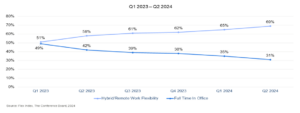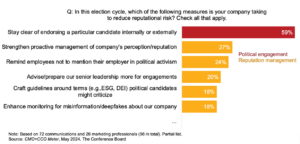Thought of the Week:
The political events over the past two weeks and a private email conversation I had with a professor from my GWU grad school days got me thinking about the law of supply and demand. I know what you’re thinking… “Me too, what else would Supreme Court decisions, a presidential debate, the NATO summit, and the runup to the political conventions make one think about.” You remember the law of supply and demand, Adam Smith’s “Invisible Hand,” from your Econ 101 class freshman year. At its most basic level, the law depicts demand as a downward-sloping curve showing the quantities of a particular good or service that buyers would be willing to purchase at various prices. Similarly, the upward-sloping supply curve shows the quantities that sellers will offer for sale at each price over the same time frame. By plotting the two curves together, a single point at which the two curves intersect is revealed. This point depicts the single price and quantity at which equilibrium is achieved. Prior to the past two weeks there was a point of equilibrium for which the demand for and supply of accurate, unbiased political information existed. I would hold that the demand for objective, nonpartisan information has increased over this same two-week time frame. If market dynamics hold, this would mean that the entire demand curve on our graph has shifted to the right. Typically, a shift in the demand curve would not only increase the quantity of the good or service supplied but also the price at which that good or service is delivered. Fortunately, for all of you, the Washington office’s network of consultants, think tanks, and trade associations has contacts across the entire political spectrum that can help meet your demand for accurate political, policy, and macroeconomic information. And contrary to the laws of economics, this information can be offered to you at no additional price.
Thought Leadership from our Consultants, Think Tanks, and Trade Associations
Bloomberg Government Sees Lobbyists Bracing for Earth-Moving Change. Lobbyists are expecting a major transformation in the way Washington works, and how they influence Congress and the executive branch, following the Supreme Court’s decision to overturn the Chevron deference doctrine. The longstanding doctrine, overturned in a 6-3 decision, meant that lower courts gave deference to executive branch agencies when they issued the regulations to implement laws Congress wrote while leaving plenty of room for interpretation. Congress, and the lobbyists who seek to influence what it does, will now need to craft much more detailed and specific legislative text and not leave the details to federal agencies. The decision could fundamentally transform how Washington works, and it may force a different type of engagement from K Street in terms of engaging with greater specificity and precision regarding legislative text. For lobbyists, this means a much more intensive level of engagement with the Congress, with the understanding that agencies will be more constrained. Big lobbying groups, such as the U.S. Chamber of Commerce, had weighed in on the case, urging the Supreme Court to overturn Chevron deference. For business, the hope now is that federal agencies will take a more cautious, less sweeping approach to their regulations. In addition, the new protocol may tilt power toward congressional committees and away from leadership, relying more on subject expertise in a way Congress has not. One practical consequence: if you think 1,000-page omnibus bills are annoying to read, wait until they’re 5,000 pages because staff will have to write things out clearly.
Conference Board Says a 50% Office Occupancy Rate Means Trouble for U.S. Cities. More than four years after the onset of the COVID-19 pandemic, a significant and likely long-term shift in the way offices are used is taking place. As employers continue to embrace hybrid and remote work models, the decline of in-person office occupancy rates is having a major impact on U.S. cities. Employees in metropolitan areas with longer commutes, higher costs of living, and concentrations of knowledge-based industries are embracing hybrid/remote work, resulting in lower in-office occupancy. The average weekly in-person occupancy rate has stabilized at near 50%, and this has been the standard since Q4 2022. In fact, employers are continuing to adopt hybrid and remote work flexibility as employees have shown this as a priority. Amid a still-tight labor market, flexibility gives employers leverage in hiring and retaining staff. An estimated 69% of U.S. companies are offering hybrid or remote flexibility to employees, up from 51% in Q1 2023. Still, the decline in office occupancy bears significant consequences for the commercial real estate (CRE) industry and cities. Increasing vacancies are weighing on tax revenue and CRE valuations, and threatening losses for lenders that may destabilize financial markets and raise the cost of capital for all firms.

“Inside Baseball”
Punchbowl News Asks What Campaign Season Chaos Could Spell for Economic Policy? It’s been a terrible two weeks for President Biden since the June 27 debate, and the panic among Democrats is palpable. With President Biden’s campaign at a critical point, Washington is thinking more about the reality that Republicans could sweep the November elections, although there’s a long way to go and the dynamics around Biden’s candidacy are shifting daily. Things are going former President Trump’s way right now, and the polling shows it. That’s reverberating through everything, from campaign strategy to legislative plotting. For tax and financial policy, the stakes are high. GOP control next year would have huge consequences for the trillions of dollars in tax cuts and the future of financial regulation. Highlighted below are some of the policy dynamics to watch if Republicans maintain their advantage at the ballot box. First, control next year would come at the best possible time for Republicans when it comes to tax policy. Their signature 2017 law—known colloquially as the Trump tax cuts—largely expires at the end of 2025. It might still be messy extending the cuts, but it would be simpler. Republicans in both chambers have set up tax working groups to prep for 2025, so they have insight about anything they might want to tweak or where members might have issues. With the GOP in control, some Democrat policies from the Inflation Reduction Act could also get undone. And it would be difficult seeing the IRS’ remaining $60 billion in long-term funding sticking. Clean energy tax credits would also be a GOP target, although regional benefits might make them more difficult to roll back. Second, a one-term Biden administration would ensure that many major rulemakings proposed by Democratic policymakers since 2021 would be rolled back. Republicans were successful undoing Obama-era regulations at the start of Trump’s term in 2017. Now, there’s a clear playbook to scrap any late Biden administration rules that the GOP doesn’t like. An incomplete list of major, yet-to-be-finalized regulations includes Basel III capital reform, changes to long-term debt requirements among large banks, and several proposals out of the CFPB. There are also plenty of financial services rules that are finalized but frozen in place due to an onslaught of legal challenges brought by industry. When courts overturn any of those rules, agencies will have little time to re-propose them. Third, former president Trump loves to talk about tariffs and toss out expansive policies to slap charges on imports. He’s floated a string of tariff ideas recently, though some Republicans have downplayed those proposals as more about negotiating tactics than concrete intentions. Regardless, Trump likes the sound of a trade war and could set new tariffs with big implications for trade, foreign policy, and consumers’ wallets.
In Other Words
“It’s up to the president to decide if he is going to run. We’re all encouraging him to make that decision because time is running short,” former House Speaker Pelosi (D-CA) deferring to President Biden’s own judgement on whether he exits the race while simultaneously encouraging policymakers to keep their views private. The former Speaker is highly credible within her party, has little to lose, and is best positioned to solve Democrat’s first-mover problem—an option kept open by her intentionally ambiguous statement.
“I’m getting frustrated by the elites in the party, ‘Oh, they know so much more.’ Any of these guys that don’t think I should run, run against me. Announce for president, challenge me at the convention,” President Biden, calling into MSNBC’s Morning Joe attempting to quell panic that he is unfit to be the nominee.
Did You Know
The Trump Campaign is Proposing a Higher Tea Tax than George III. Consider that the current “MFN” tariff on black and green teas is 0%; the present “301” tariff applied to Chinese tea is 7.5%; the “Tea Act of 1773” carried a tax of 8%; and former president Trump’s campaign proposal is for a 10% tax. The British Parliament’s Tea Act of 1773 was essentially a bailout of the East India Company (EIC). In modern terminology, the EIC was a “state owned enterprise,” and by the late 18th century it governed parts of India. Its conquest of Bengal in the 1760s left the company nearly bankrupt. To rebuild its finances, the Tea Act authorized the EIC to ship unwanted tea to the Atlantic colonies with a waiver of the regular 25% export tax; however, the Act left in place an existing 3-pence-per-pound tariff to be paid by colonial buyers and stipulated that the EIC was the only entity allowed to sell tea to the colonies. Today, Argentina is the top source of U.S. tea at 43 million kilos, or nearly half of 2023’s 104 million-kilo total; India, China, Vietnam, and Sri Lanka come next by tonnage; but Japan earns the most selling tea to Americans—their 3,500 tons of high-end sencha and matcha brought in $105 million of the $493 million worth of imports last year.
Graph of the Week
In a Hyperpolarized and Even More Divisive Election Season than 2020, Companies Aim to Play it Safe with their Words and Actions. A survey of communications and marketing professionals indicates just how cautious, vigilant, and preemptive companies are being to protect their reputations by mitigating potential internal tensions and external attacks. Executives’ biggest election-related fears are their company being pulled into the political discussion and employees creating tension in the workplace.
